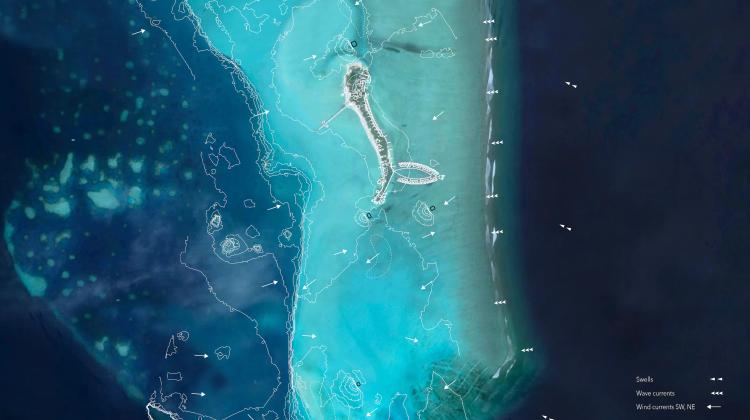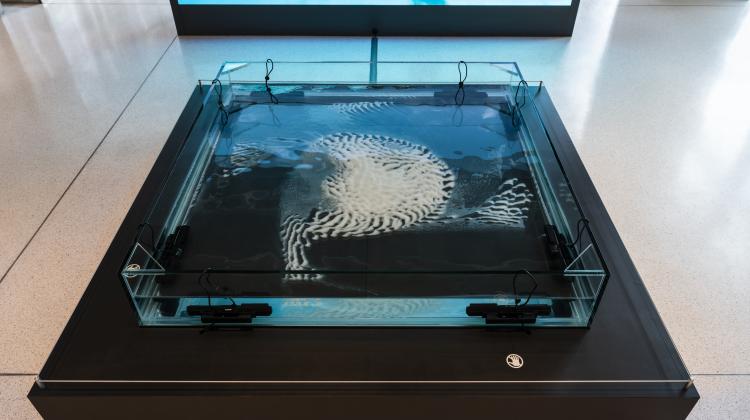Growing Islands

Growing Islands exhibit at the MIT Museum (Photo: Anna Olivella)

Aerial photo of Self-Assembly Lab and Invena research on growing islands in the Maldives. Photo courtesy of the researchers

The museum exhibit includes a tank with several pumps that mimic how sand and water move. (Photo: Anna Olivella)
Architecture’s Skylar Tibbits says the key to better designing our cities may be spending more time working and playing with sand.
An exhibit now on view at the MIT Museum offers visitors a new way to reflect on the dynamics of beach erosion and possible approaches to combating sea-level rise. A large tank filled with water and sand — and fueled by eight air pumps — shows how waves can shape sand into sandbars and islands. Visitors love the exhibit, says Martha Davis, communications officer for the MIT Museum.
The exhibit, Growing Islands, is based on experiments by the MIT Self-Assembly Lab in the School of Architecture and Planning’s Department of Architecture in collaboration with Invena, a Maldivian organization. The research, based in the Maldives in the Indian Ocean, tests how to maintain and build islands threatened by erosion by working with the ocean’s natural movements. Skylar Tibbits, an associate professor, director of the Self-Assembly Lab, and director of MIT’s design major and minor programs, leads the research team.
Q: How has your background in design supported your work on this project?
Tibbits: A background in design is the only way we could have come to this approach. What we’re proposing to do is passively grow islands through collaborating with the forces of nature. That kind of approach is not necessarily something you would come to from any of the traditional disciplines. Design allows us to think big, ask big questions, dream, imagine what’s possible, and work toward making it happen.
That kind of approach is what led me early on into the world of self-assembly and self-organization, and toward seeing if we can use the phenomenon on a large scale, such as in manufacturing and construction.
Q: What motivated you and the Self-Assembly team to take on this specific research project?
Tibbits: Through serendipity, we connected with a group from the Maldives that came to our lab to look at our textiles research. They invited us to the Maldives to see if we wanted to do some of our self-assembly work there. It became very clear that it was the sand that we wanted to focus on. These are low-lying islands and very vulnerable to climate change, and there are many urgent issues regarding erosion. We went to one of the sand bars and something clicked for me: there was a good-sized island that had showed up out of nowhere. I was kind of blown away by it. It formed itself. Then we focused on how to guide this to happen so it’s not just random.
In the near term, we’re trying to overcome erosion in the islands by passively accumulating sand. We’ve done five different full-scale field installations to date. We’re also looking at building new islands. We want to avoid dredging because it is very harmful to the environment. The Maldives economy is dominated by tourism. We want to see if we can build a new island passively, in tune with the environment. If we can build a new island, we can potentially also accumulate sand to protect existing islands.
Is this approach something that would help other areas facing significant erosion, such as on Cape Cod?
Tibbits: Yes. The largest vision: we could use this kind of approach on any island nation or coastal region in the world. Many places are going under water with sea-level rise or are severely impacted by erosion. The current options — building jetties or other barriers — are not successful. Sometimes they even amplify the negative effects. Static structures are not going to work well in a dynamic environment. Even if it works today, it won’t work in the long term. Dredging is the other approach, and it’s also ineffective and harmful to the ocean environment. However, every location is complex and has different forces or environmental conditions, so the solution in one location will likely need to be adapted to fit many different conditions.
What would you like museum visitors to take away from this exhibit?
Tibbits: The tank is a playful, visual tool. It’s a never-ending sandbox that just keeps changing. We hope visitors will be intrigued by it, connect with it, and begin to ask questions about how this work might be applied on the coasts here in Massachusetts or in their own communities.
One of my biggest takeaways from my first trip to the Maldives was that I think the islands are a better model for how we build cities such as New York. These islands are likely going to outlive our manmade cities because they’re growing, changing, and adapting. They’re highly dynamic. New York or Boston or Miami are highly fixed. At some point, it can’t grow bigger or adjust or fluctuate. That’s probably not the model that we want in the future. I think there is something interesting here. If we could just listen to the sand, we might be able to design our cities in a better way.
-- Interview conducted by Maria Iacobo


